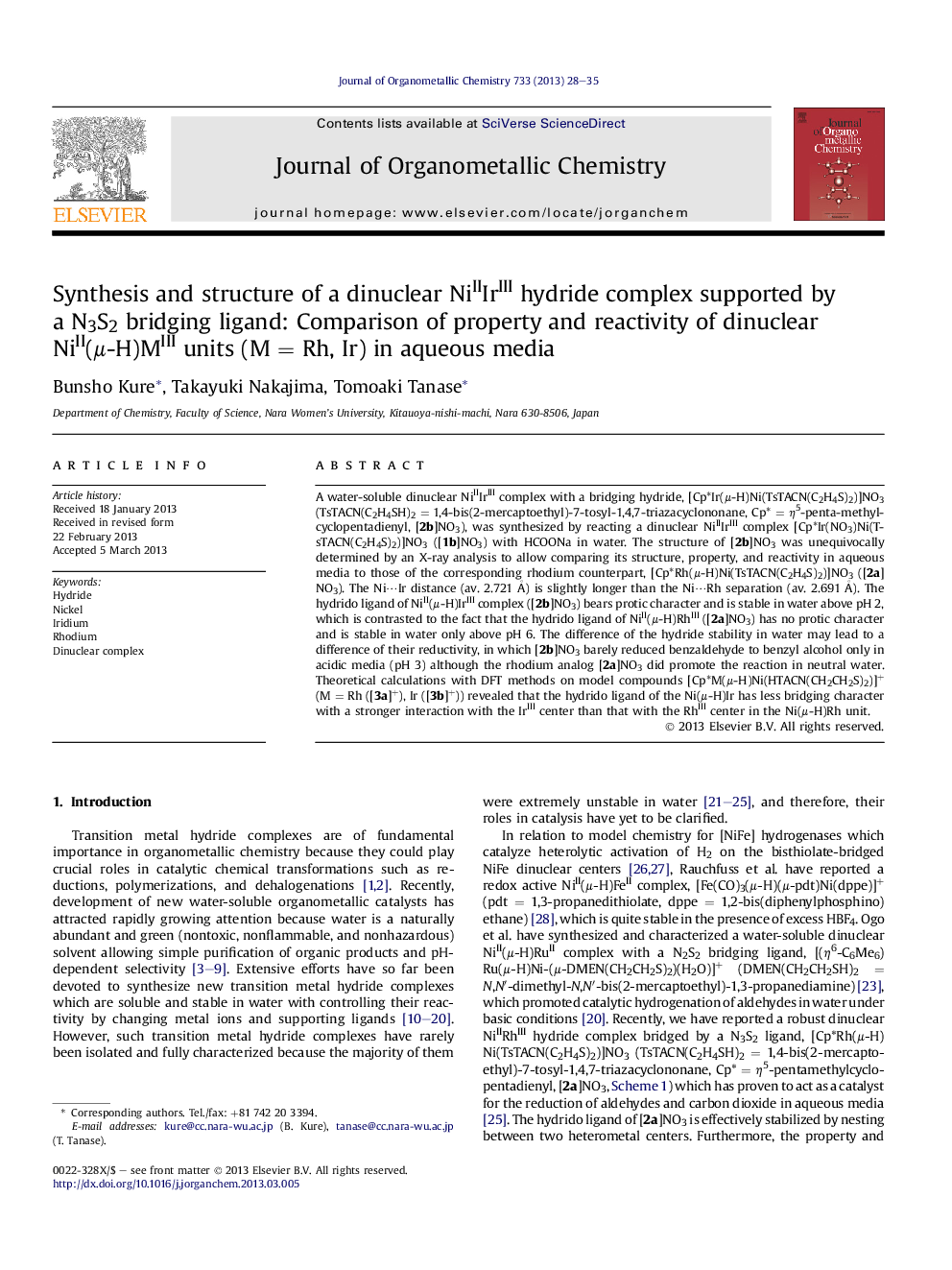| Article ID | Journal | Published Year | Pages | File Type |
|---|---|---|---|---|
| 1321844 | Journal of Organometallic Chemistry | 2013 | 8 Pages |
•A novel water-soluble dinuclear NiIr hydride complex was synthesized.•The structure of the hydride complex was fully characterized by an X-ray analysis.•The NiIr hydride complex is more stable than the corresponding Rh derivative.•The hydrido ligand shows a protic character.•The natures of Ni(μ-H)M bonds (M = Ir, Rh) were analyzed on the basis of DFT calculations.
A water-soluble dinuclear NiIIIrIII complex with a bridging hydride, [Cp*Ir(μ-H)Ni(TsTACN(C2H4S)2)]NO3 (TsTACN(C2H4SH)2 = 1,4-bis(2-mercaptoethyl)-7-tosyl-1,4,7-triazacyclononane, Cp* = η5-penta-methylcyclopentadienyl, [2b]NO3), was synthesized by reacting a dinuclear NiIIIrIII complex [Cp*Ir(NO3)Ni(TsTACN(C2H4S)2)]NO3 ([1b]NO3) with HCOONa in water. The structure of [2b]NO3 was unequivocally determined by an X-ray analysis to allow comparing its structure, property, and reactivity in aqueous media to those of the corresponding rhodium counterpart, [Cp*Rh(μ-H)Ni(TsTACN(C2H4S)2)]NO3 ([2a]NO3). The Ni⋯Ir distance (av. 2.721 Å) is slightly longer than the Ni⋯Rh separation (av. 2.691 Å). The hydrido ligand of NiII(μ-H)IrIII complex ([2b]NO3) bears protic character and is stable in water above pH 2, which is contrasted to the fact that the hydrido ligand of NiII(μ-H)RhIII ([2a]NO3) has no protic character and is stable in water only above pH 6. The difference of the hydride stability in water may lead to a difference of their reductivity, in which [2b]NO3 barely reduced benzaldehyde to benzyl alcohol only in acidic media (pH 3) although the rhodium analog [2a]NO3 did promote the reaction in neutral water. Theoretical calculations with DFT methods on model compounds [Cp*M(μ-H)Ni(HTACN(CH2CH2S)2)]+ (M = Rh ([3a]+), Ir ([3b]+)) revealed that the hydrido ligand of the Ni(μ-H)Ir has less bridging character with a stronger interaction with the IrIII center than that with the RhIII center in the Ni(μ-H)Rh unit.
Graphical abstractA water-soluble dinuclear NiII(μ-H)IrIII complex, [Cp*Ir(μ-H)Ni(TsTACN(C2H4S)2)]NO3 ([2b]NO3), was synthesized and its structure was determined by X-ray analysis. Both experimental and theoretical study revealed that the hydrido ligand of the Ni(μ-H)Ir has less bridging character with a stronger interaction with IrIII than that with RhIII in the Ni(μ-H)Rh unit.Figure optionsDownload full-size imageDownload as PowerPoint slide
